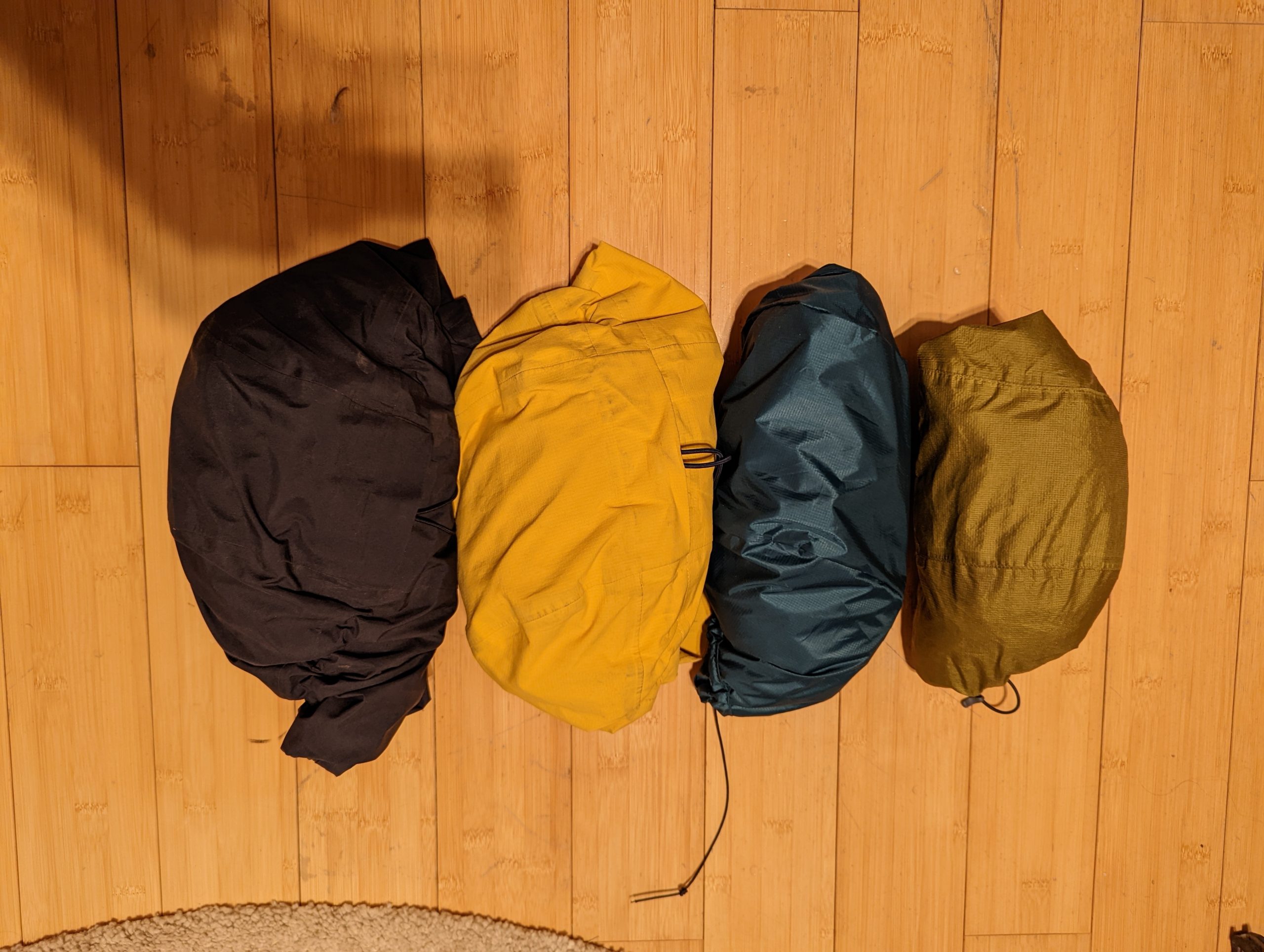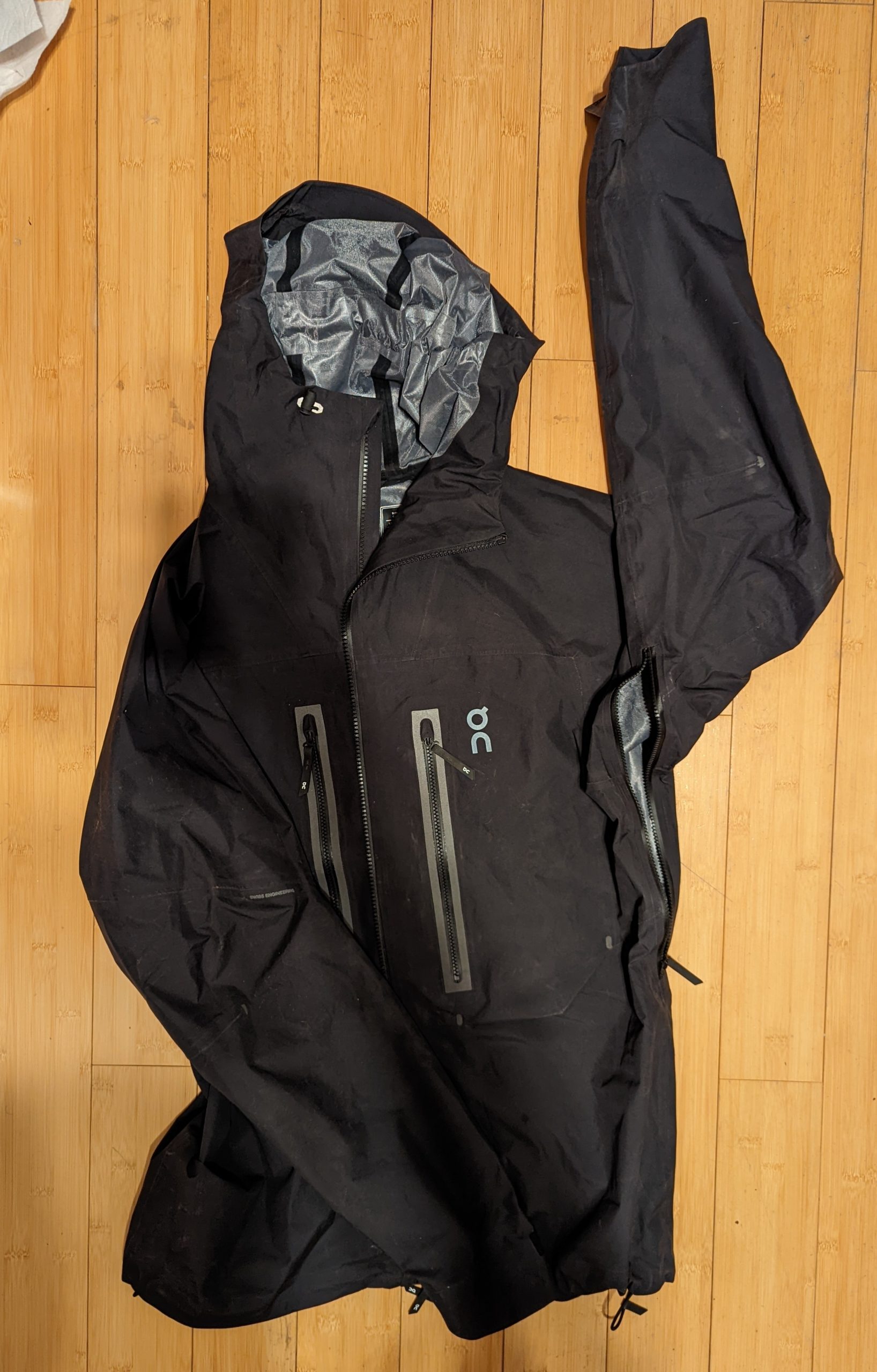On Storm Jacket Review
The On Storm Jacket is a waterproof breathable (WPB) rain jacket that strikes a balance between weight and performance. While not the lightest WPB jacket on the market, it remains fully featured for shoulder season use.
On Storm Jacket At-a-Glance
MSRP: $429
Weight: 14.3oz (Men’s size medium) Listed at 13.4oz
Material: 3-Layer assembly with Recycled Polyester, PFAS-free DWR (more on this later)
Intended Use
This midweight jacket is best for persistently wet conditions in colder environments. The mechanical ventilation helps with active use and the thicker material helps with windier, colder conditions.
Circumstance of Review
I used this jacket from late fall to early winter in Colorado’s high country and Utah’s southern deserts. I encountered significant temperature swings during my testing: anywhere from 15 to 75 degrees.
READ NEXT – The Best Rain Jackets for Thru-Hiking
Features
Three-Layer, Seam-Taped Construction
This jacket uses a fully layered construction for comfortable wear as a next-to-skin layer and quality weather protection. On didn’t publish the denier rating or what type of WPB membrane was used, but it seems comparable to other ‘hard-shell’ rain jackets I have used at a slightly lighter weight. The seam taping is well executed: it covers all the sewn edges without being excessively wide (which would increase the weight and stiffness).
Giant Pit Zips
While breathable fabrics are nice, mechanical ventilation is king. The pit zips on this jacket measured in at 12″ with the same chunky zipper used for the front zip. For comparison, I consider six-inch zips inadequate, with nine inches the minimum for actual ventilation.
Hipbelt Compatible Pockets
The “hand pockets” on this jacket sit higher on the jacket near the chest area, keeping them accessible while hiking with a pack. Note that the zippers are on the “inside” of the pocket (near the main zipper), meaning you have to reach across to use them. Instead of left-hand-left-pocket, these are easier to use left-hand-right-pocket. There is also an inner pocket to keep small items out of the weather.
Elastic Hood and Waist Cinches
This jacket has three elastic cinch cords (over the head/brim, around the back of the head, and waist) as well as velcro strips on each wrist to help batten down the hatches in bad weather. The brim cord is tightened near the collarbone, but the slack is threaded internally to the pockets. This prevents loose ends from slapping you in the face.
Space To Layer
Wearing a base layer, a midweight fleece (Melly), and a midweight puffy (Arcteryx Cerium LT), I filled the extra volume in the jacket without overly compressing the down. Wearing just a base layer, the Storm Jacket is roomy without being too baggy to be active in. This makes it a great shoulder season pick. When used with a thin T-shirt, it’s quite baggy on my narrow frame.
Rain Jacket Design
There’s a surprising breadth of design approaches to the simple rain jacket.
Mechanical Ventilation
This jacket uses pit zips and a full front zipper to vent instead of relying solely on the breathable fabric.
DWR and WPB
While non-breathable jackets are making a comeback, most hikers still insist on a “breathable” fabric. What’s the difference? WPB (waterproof breathable) fabrics use a mid-layer with microscopic pores that allow water vapor to pass, but not liquid water (Goretex is the brand name version of this tech, but many companies make their own variant). This allows body sweat and hot air to escape while keeping cool rain out.
Unfortunately, this microporous fabric is delicate and is almost always protected by a face fabric. This fabric needs to remain dry to allow air and water vapor to pass, which is where DWR comes in. Durable Water Repellent is a chemical treatment that repels water to keep the face fabric dry. It can also help keep you dry from the inside by letting sweaty body heat escape. In contrast, non-breathable layers always need to be well-vented to prevent “wetting out” from the inside.
The name is ironic since DWR typically is not very durable, needing to be refreshed every year (or more with heavy use). Most rain jackets shed water like champions when new but eventually “clog” when the DWR wears off and the face fabric starts to wet. During the last few months, I have not noticed a significant change in the face fabric of the Storm Jacket—the DWR is still going strong.
On chose a DWR formula that doesn’t include PFAS, otherwise known as “forever chemicals.” This helps protect sensitive environments.
Non-Waterproof Zippers
This jacket does not use waterproof zippers. Instead, the main zipper has a flap behind it that helps keep any intruding water from soaking into your clothing. The pockets and pit zips don’t have a flap, but the back of the pocket is the same waterproof material as the shell.
Picking one or the other is a tradeoff. No-waterproof zippers are easy to use, more reliable/durable, and easier to fix when something goes wrong. However, water can soak through them by running down and around the flap. I prefer non-waterproof zippers to have an exterior flap rather than the interior flap on the Storm Jacket.
Waterproof zippers, on the other hand, keep water out completely at the cost of easy use and repair (A local repair shop charges $30 for normal zipper replacement and $80 for waterproof zipper replacement, for example).
Roominess
This jacket is middle-of-the-road in terms of body volume. The thickness of the material lends itself to shoulder season use, so it’s nice to have room to layer. A more athletic fit would make it lighter and better for summer use. The neck is tight and tall, which I prefer for really closing things up when the weather gets bad.
The hood is also large enough to fit my climbing/mountaineering helmet (Petzl Meteor) but cinches down enough to remain comfortable without a helmet. The hood’s ability to do both well is actually its most impressive feature to me.
Pockets
Quite a few jackets forgo pockets, especially in the UL category. This jacket has three (two exterior and one interior). This adds weight but lets you keep things like your phone, snacks, and map accessible.
On Storm Jacket Pros
Fit
I have trouble with top layers because of my proportions; I’m 6’1″, 135 pounds off trail, and have about three inches longer than average arms. This usually leaves me to either drown in a size L/XL to get full sleeve coverage, or get a Medium for torso volume and deal with short sleeves. I was surprised that everything fit well, including the tightness of the neck guard, body volume (with layers), and sleeve length. Could I use another inch of sleeve? Sure, but I’ve said that about everything I have ever owned.
Storm Coverage
The elastic system can really tighten this jacket and provide full coverage. The front zipper and fabric also are tall enough to cover a lot of the face. Looking straight out, it comes up to my bottom lip and stays tight. If I look down (as I often do in rain), it hits the bottom of my nose. You can always unzip to free up your face.
On Storm Jacket Cons
Price
$430 for a jacket? Ouch. It’s pretty fully featured and is comparable to other jackets at the price point, with the notable exception of waterproof zippers.
Weight / Packed Volume
The weight is pretty average for a hardshell. When you consider it has full-sized zippers, pit zips, and multiple elastic sleeves, 14 ounces actually sounds pretty reasonable. That said, it still weighs over twice as much as the popular Outdoor Research Helium Jacket (6.5oz).

Left to right: On Storm Jacket, Patagonia Cloudridge (2018), Lightheart Silpoly jacket, Outdoor Research helium. I could pack the last two about 25% smaller if desired.
Pockets Aren’t Suitable for Resting Hands
While I like the high pockets for staying out of the way of the hipbelt, you have to cross your arms uncomfortably to keep your hands in them. If they had placed them more to the outside, you could rest your arms in them easier. Bring waterproof gloves if you want to keep your hands dry and warm.
Front Zipper Sticks at the Seam
While it’s generally easy to operate the chunky front zipper, I find it gets stuck where the zipper crosses a fabric seam near the clavicle. If I want to zip it up all the way, I found myself having to work at it more than should be needed. I also found it hard to get started from open on several occasions due to the double zipper pull. If you have the jacket completely zipped, there is a second pull at the bottom. This is handy in some situations (wearing a harness, accessing waistband pockets and buttons) but not needed for backpacking.
Overall Value
At $430, I’d hardly call this jacket a bargain. While winterized jackets are typically pretty expensive, I still think there are better deals out there. That being said, I will continue using this jacket in cold/wet conditions (mostly in the sub-40-degree range). And as with all apparel, many retailers run mad end-of-season discounts. If you’re not in a rush, wait for big sales and do some price shopping.
Shop the Men’s On Storm Jacket
Shop the Women’s On Storm Jacket
Comparable Rain Jackets
MSRP: $450
Weight: 13.9 oz
Outdoor Research Dryline Jacket
MSRP: $150
Weight: 13.4 oz
The On Storm Jacket was donated for purpose of review
This website contains affiliate links, which means The Trek may receive a percentage of any product or service you purchase using the links in the articles or advertisements. The buyer pays the same price as they would otherwise, and your purchase helps to support The Trek's ongoing goal to serve you quality backpacking advice and information. Thanks for your support!
To learn more, please visit the About This Site page.




